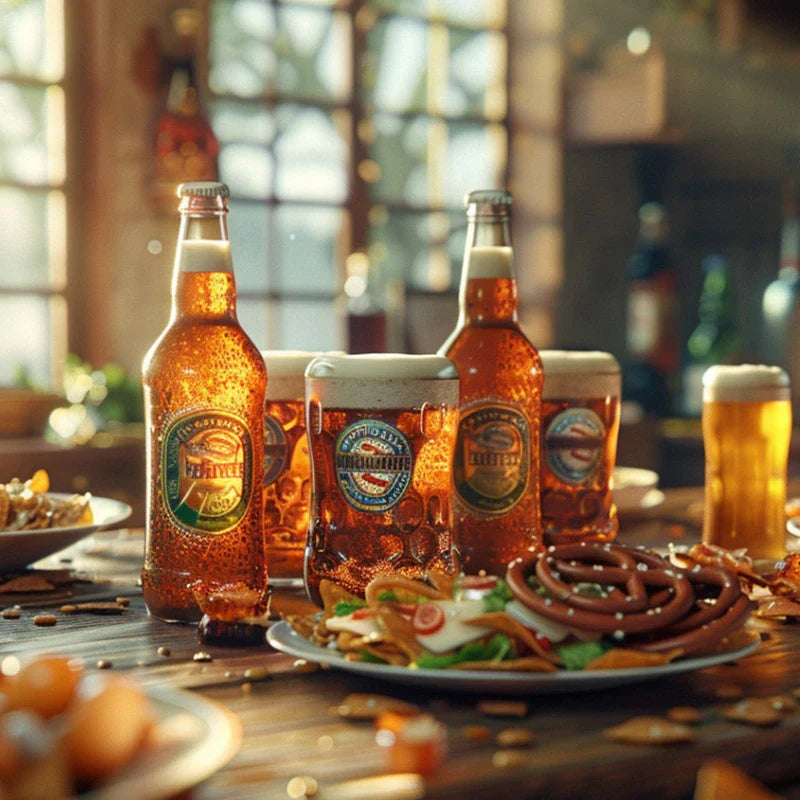Low-Calorie Beer: A Guide to Lighter Brews
Learn how to identify low-calorie beers, compare ABV levels, and find the best light beer options for your lifestyle.

In the United States, a low-calorie beer is typically defined as having around 100 to 110 calories per 12-ounce (355ml) serving.
In the European Union (EU), there is no standardized definition for low-calorie beer. According to Regulation (EU) No 1169/2011, alcoholic beverages containing more than 1.2% alcohol by volume (ABV) are exempt from mandatory nutrition labeling, including calorie information.
Best Low-Calorie Beers (U.S. & International)
|
Beer Name |
Calories (per 12 oz) |
ABV |
Carbs |
Flavor Profile |
|
Michelob Ultra |
95 |
4.2% |
2.6g |
Crisp, light malt flavor |
|
Bud Light |
110 |
4.2% |
6.6g |
Mild hop bitterness, smooth finish |
|
Coors Light |
102 |
4.2% |
5g |
Refreshing with subtle maltiness |
|
Miller Lite |
96 |
4.2% |
3.2g |
Light-bodied with a balanced taste |
|
Amstel Light |
95 |
3.5% |
5g |
Smooth, slightly bitter European-style lager |
|
Corona Premier |
90 |
4.0% |
2.6g |
Crisp with mild citrus notes |
|
Heineken Light |
99 |
3.3% |
7g |
Malty with a hint of hops |
|
Guinness Draught (Surprisingly Low-Cal) |
126 |
4.2% |
10g |
Creamy with roasted malt flavors |
|
Oskar Blues One-y IPA |
100 |
4.0% |
5g |
Hoppy, citrusy, lower bitterness |
|
Dogfish Head Slightly Mighty IPA |
95 |
4.0% |
3.6g |
Fruity hops with a dry finish |
Where Do Beer Calories Come From?
The calorie content in beer comes primarily from alcohol and carbohydrates.
1.Alcohol (Ethanol) – The most calorie-dense component in beer, providing 7 calories per gram. Beers with higher ABV (alcohol by volume) have more calories.

2.Carbohydrates (Residual Sugars & Malt) – Derived from malted grains, contributing 4 calories per gram. Low-carb beers reduce this by fermenting more sugars into alcohol, leaving fewer residual carbs.
Since alcohol makes up most of a beer’s calorie count, low-calorie beers typically have a lower ABV (3-4%) to reduce overall calorie content.
How Is Low-Calorie Beer Made?
While all beers are made using the same fundamental process, low-calorie beers are brewed with techniques that reduce carbohydrates and alcohol content. The brewing process follows these key steps.
1.Malting – Barley or other grains are malted (soaked, germinated, and dried) to develop enzymes that break down starches into fermentable sugars.
2.Mashing – The malted grains are mixed with hot water, converting starches into fermentable sugars, forming the "wort."
3.Boiling & Hopping – The wort is boiled, and hops are added for bitterness and aroma.
4.Fermentation – Yeast is added, converting sugars into alcohol and CO₂.
5.Conditioning & Filtration – The beer matures, and excess yeast or sediments are filtered out before packaging.
How to Identify a Low-Calorie Beer
Since definitions of "light" or "low-calorie" beer vary by region, here’s how to quickly identify one.
●Check the Label – In the U.S., beers labeled "light" or "lite" typically contain 100-110 calories per 12-ounce (355ml) serving. In the EU, calorie labeling is not mandatory for beers over 1.2% ABV, so information may not always be available.
●Research the Brand – Many breweries list nutritional details on their websites. For example, Budweiser Select 55 contains 55 calories per 12-ounce serving.
●Consider the Alcohol Content – Beers with lower ABV generally have fewer calories. Most light beers fall between 3-4% ABV, reducing calorie density.
Different countries and organizations define "low-calorie" or "light beer" differently, often based on alcohol content and calorie limits.
Beer Calorie Chart
|
Region/Country |
Definition & Standard for Low-Alcohol or Light Beer |
|
United States (TTB - Alcohol & Tobacco Tax and Trade Bureau) |
"Light beer" is not strictly defined by law, but it typically contains fewer than 110 calories per 12 oz. There is no ABV limit, but most are 4.2% ABV or lower. |
|
European Union (EU) |
“Low-alcohol beer” refers to beers with 0.5% - 1.2% ABV, while "light beer" usually means lower calories, without a strict definition. |
|
United Kingdom (UK Government & The Portman Group) |
"Low-alcohol beer" is defined as ≤1.2% ABV, while "reduced alcohol beer" must have at least 30% lower ABV than its full-strength version. "Light beer" has no legal calorie standard. |
|
Australia & New Zealand |
"Low-alcohol beer" refers to ≤3.0% ABV, while "light beer" is usually ≤2.5% ABV. There is no official calorie requirement. |
|
Canada (CFIA - Canadian Food Inspection Agency) |
"Light beer" must contain at least 25% fewer calories than the regular version of that beer brand. There is no universal ABV standard for light beer. |
|
Japan (National Tax Agency) |
"Happoshu" refers to beers with less than 67% malt content, which often have fewer calories. Low-malt beer or "third-category beer" (like Asahi Off) contains even fewer calories and lower ABV. |
How to Choose the Right One?
●For light and refreshing taste → Michelob Ultra, Coors Light, Corona Premier
●For a balanced, fuller flavor → Miller Lite, Heineken Light, Amstel Light
●For hop lovers → Dogfish Head Slightly Mighty, Oskar Blues One-y IPA
●For a smooth dark beer → Guinness Draught (surprisingly low-calorie for a stout!)

